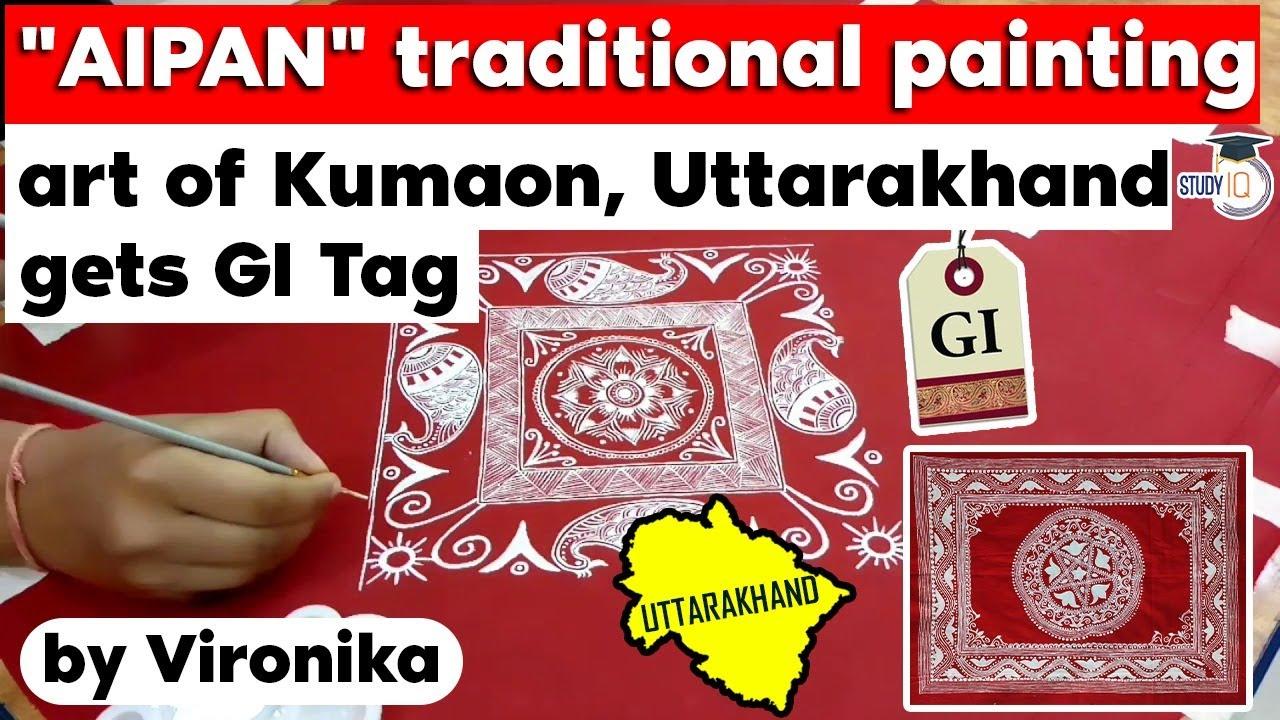Table of Contents
- Aipan is one of the traditional art (painting form) of Kumaon.
- It has great social, cultural and religious significance. Aipans are known by different names and is in popular in many parts of India with larger variations.

- It is called Alpana in Bengal, Satiya in Gujrat, Rangoli in Maharashtra, Chowk pooran in UP, Kolam in south India, Madne in Rajasthan, Arichan in Bihar and Bhuggul in Andhra
- Some of these artistic creations have great religious importance and these are drawn during particular religious ceremonies or auspicious occasions such as marriages, Threading ceremony, naming ceremony etc. to perform rituals while others are for particular God / Goddess and a few for aesthetic look.
Aipan of Door Steps
- Doorsteps of the house are decorated with this kind of aipan.
- These are beautifully designed decorative aipan with great aesthetic value.
- The door steps are decorated with this type of aipan in combination with ‘Vasudhara’ the vertical lines made by dripping the ‘biswar’ (Rice floor solution made by soaking the rice and then grinding it which is used for drawing aipan)
Different Aipan arrangements
- There are a number of different Aipan forms/motifs. Some of them are
- Saraswati Chowki: Used to commemorate a child beginning his/her formal education.
- Chamunda Hast Chowki: It is made for auspicious or sacrificial fires.
- Nav Durga Chowki: Utilized for ritual Pujas. The art is made in such a way that there are 9 dots representing the Nav Durgas.

- Shivarchan Peeth: Applied whenever worship of Shiva, the ruling god takes place.
- Acharya Chowki: In popular Hinduism, the pandit/guru is considered more important than the groom. An important motif is made for the guru.
- Astadal Kamal-This aipan is drawn at the place where ‘Havan’ is performed. It is an octagonal geometry with lotus petals and a swastik is drawn at the center.
- Lakshmi Padchinha- On Deepawali day, footprints of Goddess Lakshi are drawn from main entrance of the house to place of worship.

- Minakshi Khati, the 22-year-old from Nainital district has fondly come to be known as the Aipan girl of Kumaon, for continuously working to revive the old art form of Uttarakhand.23-Nov-2020 In December 2019, Minakshi Khati started Minakriti The Aipan Project. The project aims to revive Aipan art. Under the project so far, 1000 orders have been placed.
- The project earns income for women from rural households in Kumaon. The project employs women from such households to who produce Aipansand deliver bulk orders to their clients.
- Aipan art originated from Almora in Uttarakhand which was founded during the reign of the Chand dynasty It flourished during the reign of the Chand dynasty in the Kumaon region.
- The designs and motifs are motivated by the beliefs of the community and various aspects from nature.
- In order to protect domestic producers of various cultural and religious products like Aipan art, the Government of India set up the Uttarakhand Handloom & Handicraft Development Council (UHHDC) in 1860 under the Societies Registration Act, 1860
- It aims at generating consistent employment opportunities by promoting the domestic art products.
- A Geographical Indication (GI)is a sign used on products that have a specific geographical origin and possess qualities or a reputation that are due to that origin. In order to function as a GI, a sign must identify a product as originating in a given place.
Geographical Indications Protection
- Geographical indications are protected and preserved in various countries and regional systems through a wide array of approaches and often using a consolidation of two or more approaches.
- There are three major ways to protect a geographical indication:
- So-called sui generis systems (i.e. special regimes of protection)
- Using collective or certification marks
- Techniques concentrating on business practices, including administrative product approval schemes
- These approaches have been developed in consonance with different legal practices and within a framework of individual historical and economic conditions.
- The approaches to protect GI comprise differences with respect to critical questions like conditions for protection or the scope of protection.
- On the other hand, the two modes of protection mentioned above namely sui generis systems and collective or certification mark systems, share some common characteristics, such as the fact that they set up rights for collective use by those who comply with defined standards.
Consider the following statements regarding Aipan
- Aipanis one of the traditional art (painting form) of Kumaon.
- It is called Alpana in Bengal, Satiya in Gujrat, Rangoli in Maharashtra
Which of the above statements are true ?
a) 1 & 2 only
b) 2 only
c) 1 only
d) all of the above
Latest Burning Issues | Free PDF

























 WhatsApp
WhatsApp